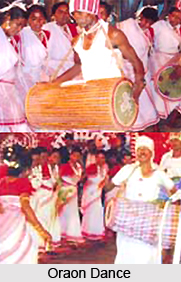 Oraon dance is a folk dance of Chota Nagpur of West Bengal state of India. It is also practiced in other Indian states such as Jharkhand, Odisha, Bihar and Chhattisgarh. Men and women equally participate in Oraon dance.
Oraon dance is a folk dance of Chota Nagpur of West Bengal state of India. It is also practiced in other Indian states such as Jharkhand, Odisha, Bihar and Chhattisgarh. Men and women equally participate in Oraon dance.
This traditional dance depicts the history of the social and religious beliefs of the orthodox people. It is a series of marriage dances which are performed according to a particular wedding. There are three types of marriages according to which each of the dances are enacted, the `ghostly weddings` celebrated at the beginning of the year, human weddings celebrated during the end of March and finally the divine weddings where the union of the Mother Earth with the Sun God is rejoiced.
Ghostly Wedding Dance
After the harvesting of the crops in the beginning of the year the women of the village unearth the bones of the dead ones from the village graveyard. They then polish them with oil and turmeric powder like those of the bridal couples. The village men then carry the bones to a stream or pool. The bones are usually carried in big processions with much celebration and music. Near the pool they are deposited. During the processions, other materials like the `karsa`-pot, and the `chumka` or lamp stand are also carried. It is utilised for presenting the dead ones as well as for blessing their union with those of their ancestors.
Foodstuffs like rice, pulses, dal, and others are also cooked for the purpose of granting a wedding feast to the newly married Oraon denizens. The food is usually left in a pit for them to eat. The Oraons also organise a dancing festival named as Harbori Jatra (bone-burial) after the wedding.
Human Wedding Dance
Later in the year, especially during the end of March a dance programme is again organised for the celebration of the human weddings. These dances and merrymaking is a sign of festivity as the girl and the boy get engaged in the holy bond of marriage. The dance features the formation of a group where the boys and girls advance and retreat from each other on a gradual phase. Their arms are interlaced and the voices are raised which sing songs of love and romanticism. Instruments like seven to eight drums accompany their dances.
Divine Wedding Dance
At the end of the year, the divine wedding of the Mother Earth and the Sun God is celebrated with much pomp and gaiety. During this time, all other wedding ceremonies must be discontinued. All the members of the village engage themselves in singing, dancing and rejoicing.
The men and the women perform dance together by arranging themselves in columns one behind the other and each holding the hand of his immediate partner. A grand religious feasting known as Sarhul is also held in honour of the divine union. The divine ceremony is performed through the marriage of the village priest and his wife who represent the Sun God and Mother Earth. The members of the village are barred from gathering or consuming any vegetable, fruit or flower of the new season before the ceremony is solemnly executed. They are also forbidden to manure the fields before the ceremony.



















